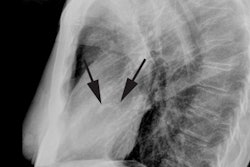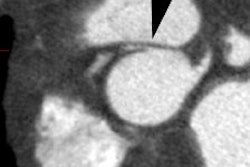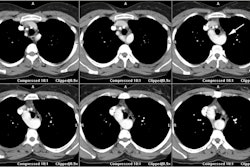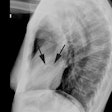Cardiac Torsion/Herniation:
View cases of cardiac torsion
Clinical:
Cardiac torsion is extremely rare, but fatal if unrecognized. There is no side predilection [3]. Even with surgical intervention, mortality approaching 50% has been recorded. Patients may present with hypotension, cyanosis, circulatory distress, or superior vena cava syndrome. Conditions which permit the development of cardiac torsion include: surgical defects within the pericardium, congenital pericardial defects, and blunt trauma with pericardial rupture.
The most widely recognized cause of cardiac torsion/herniation is
intrapericardial
pneumonectomy (most commonly right sided [5]) without closure of the
pericardial defect. In these cases herniation through
the pericardial defect with subsequent torsion can occur because of the
large potential
space created by the now absent resected lung. Negative pressure in the
affected hemithorax [5], suction via the chest tube,
coughing, or positive-pressure ventilation of the remaining lung may
contribute to the
herniation. Nearly all cases occur within 24 hours of pneumonectomy,
but delayed
herniation has been reported. The mortality rate is 40-50% [4].
Left-sided hernation is more common in the presence of congenital and
post-traumatic pericardiaefects, resulting in ventricular strangulation
[5].
CXR findings include [9]
Left herniation- a hemisphere-shaped left border with a
incisura between the great vessels and the more lateral herniated
cardiac margin. Other authors describe notching of the left heart
border (the "collar" sign), elongation of the cardiac silhouette (the
flattened boot" sign), or loss of the right heart border [5]. Bulging
of the heart border (the "snow cone" sign) is a reported finding of
impending hernation [5].
Right herniation- displacement of the cardiac apex to the right [5].
REFERENCES:
(1) Ann Thorac Surg 1992; 53: 703-705
(2) AJR 1997; Postpneumonectomy complications. 169: 1363-1370 (No abstract available)
(3) Radiographics 2002; Kim EA, et al. Radiographic and CT findings in complications following pulmonary resection. 22: 67-86
(4) Radiographics 2006; Chae EJ, et al. Radiographic and CT findings
of thoracic complications after pneumonectomy. 26: 1449-1467
(5) Radiographics 2013; Lubner MG, et al. Emergent and nonemrgent nonbowel torsion: spectrum of imaging and clinical findgins. 33: 155-173






